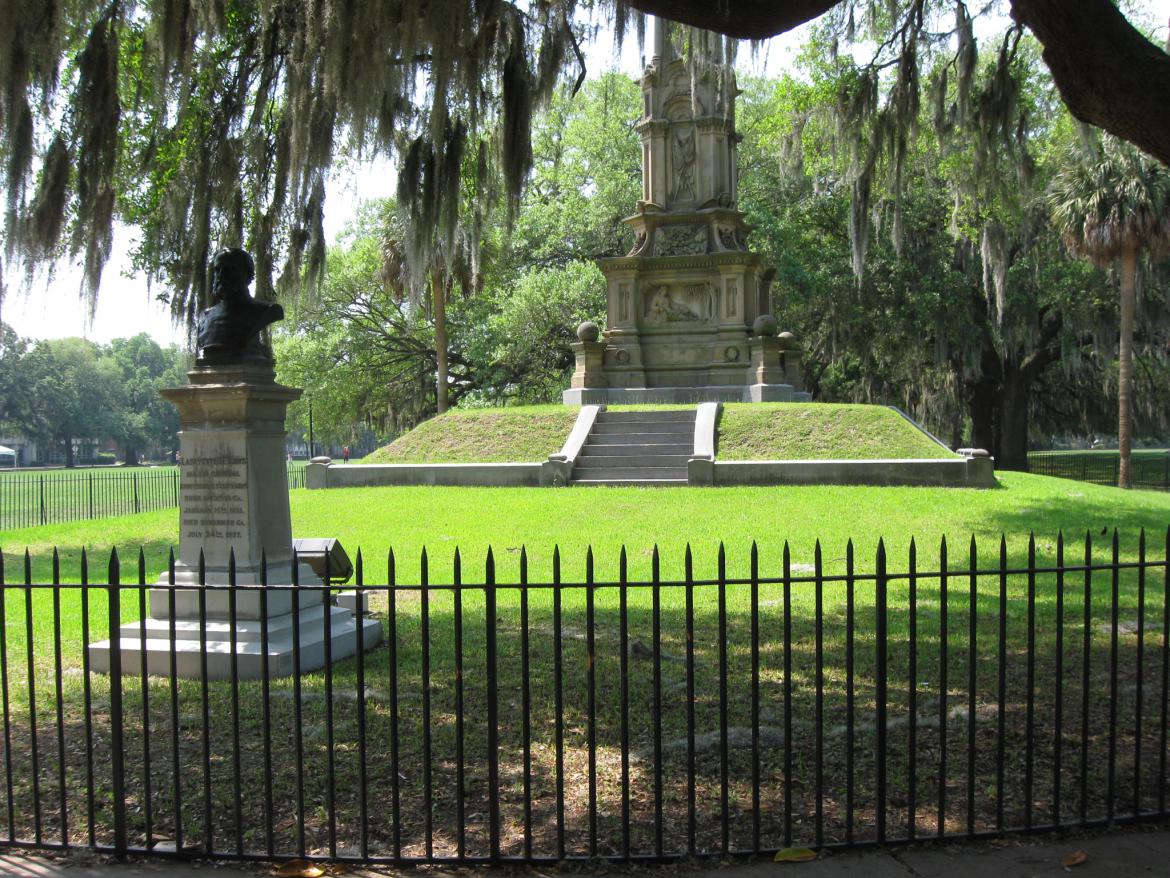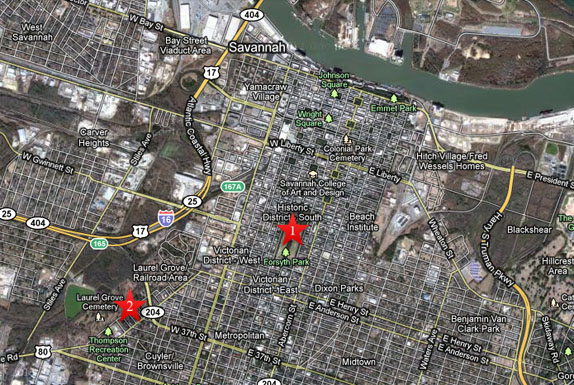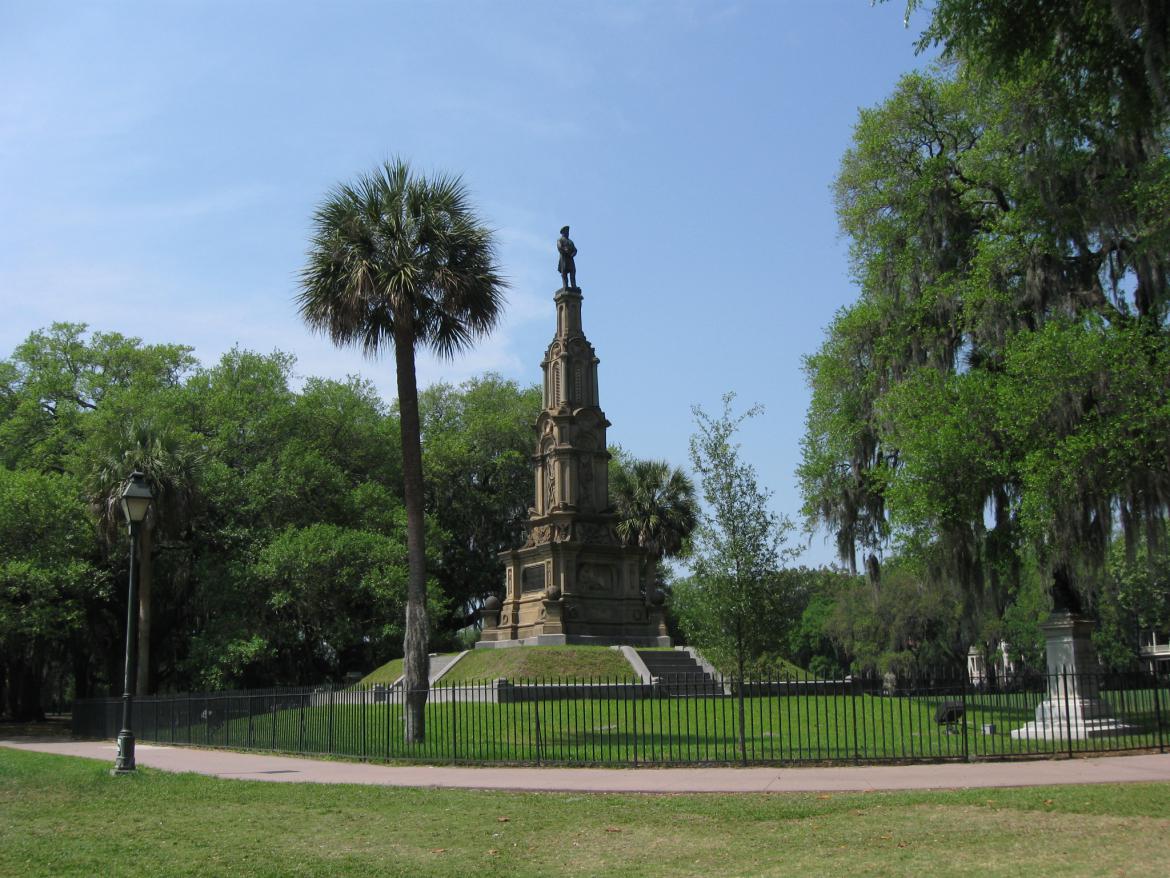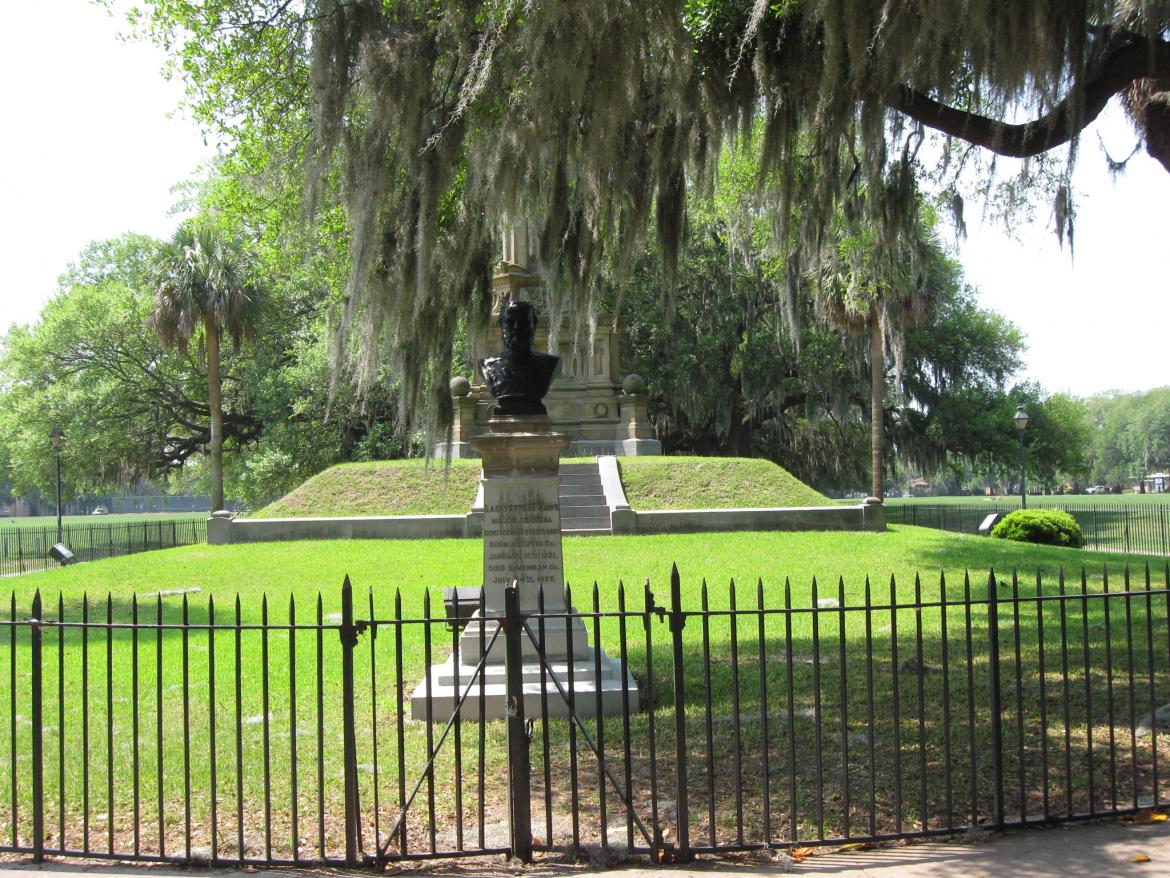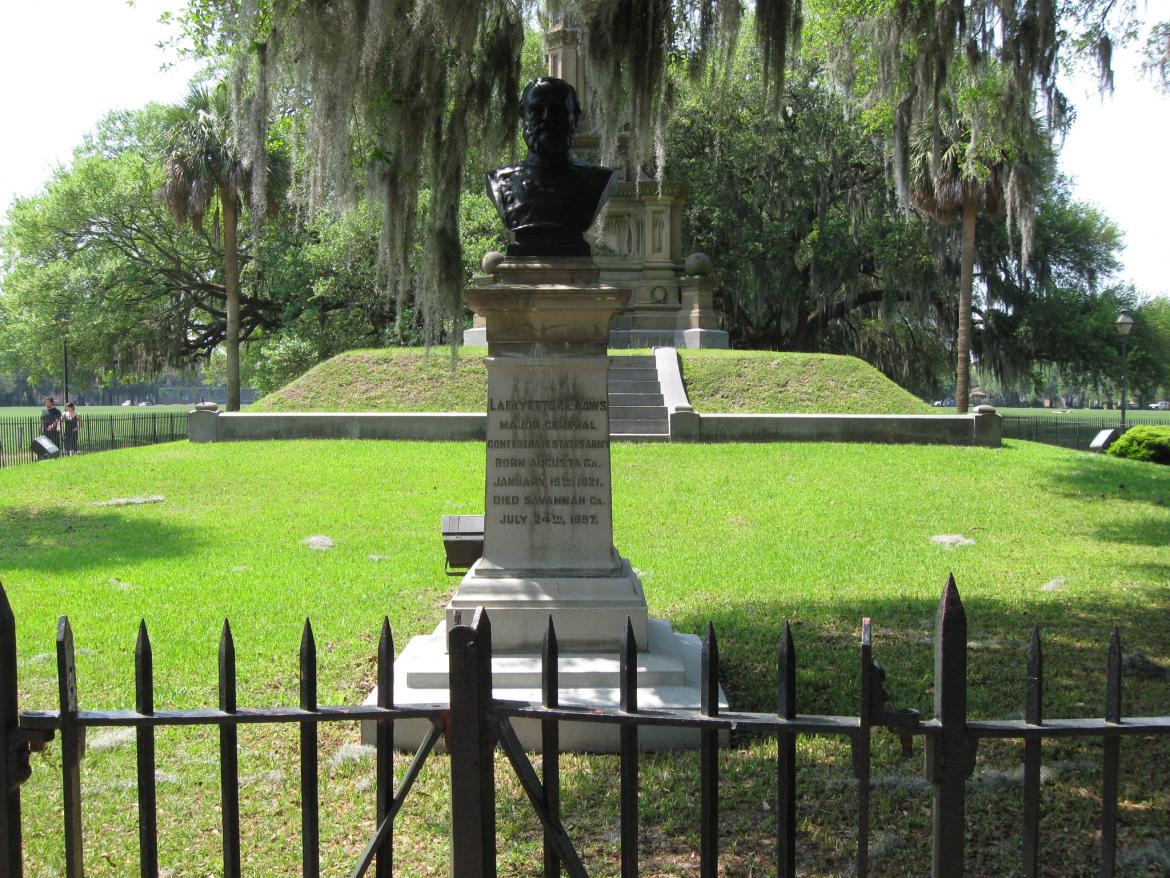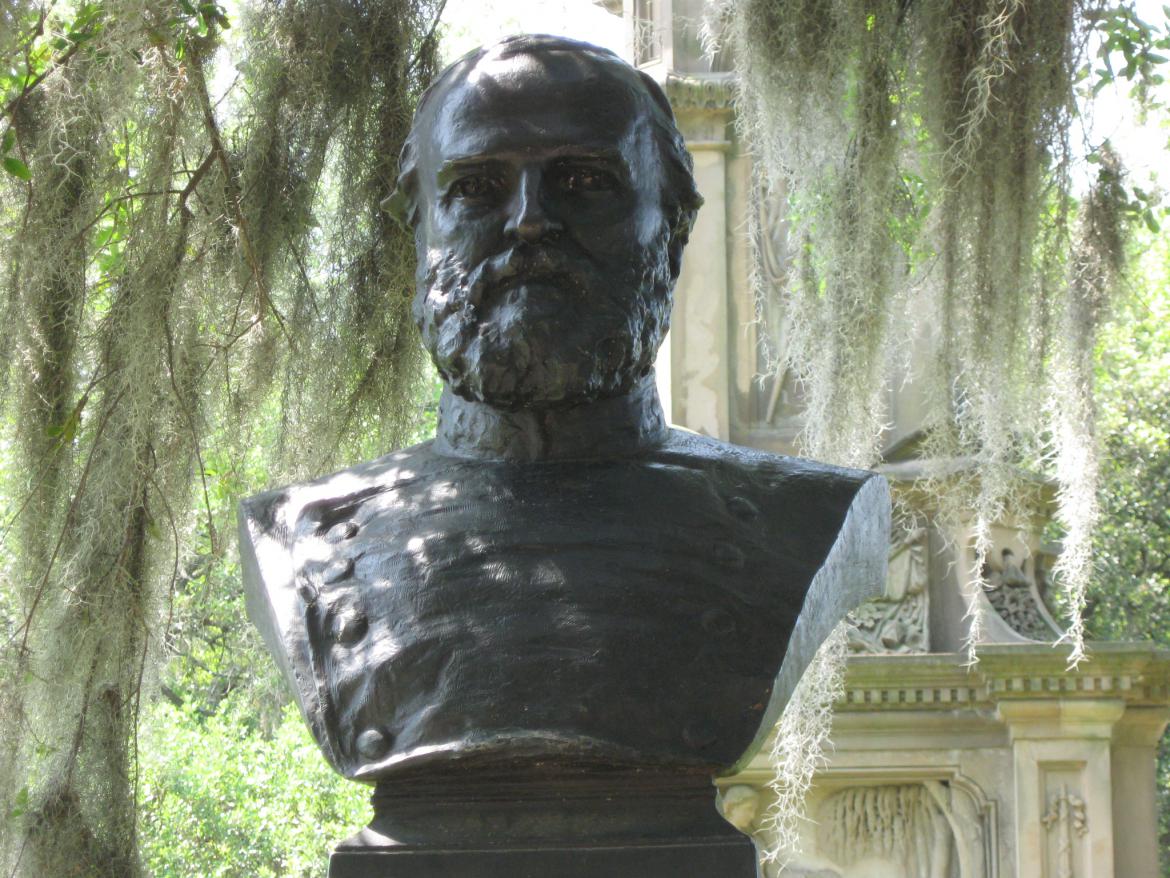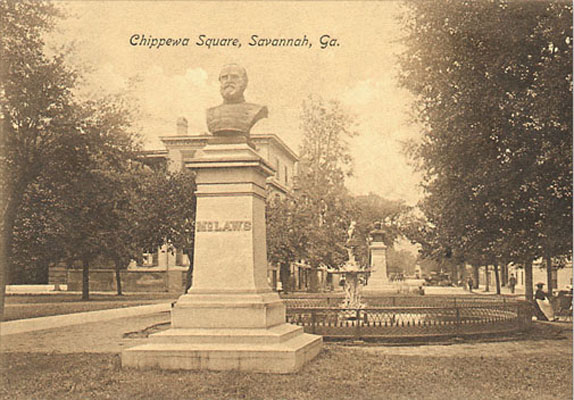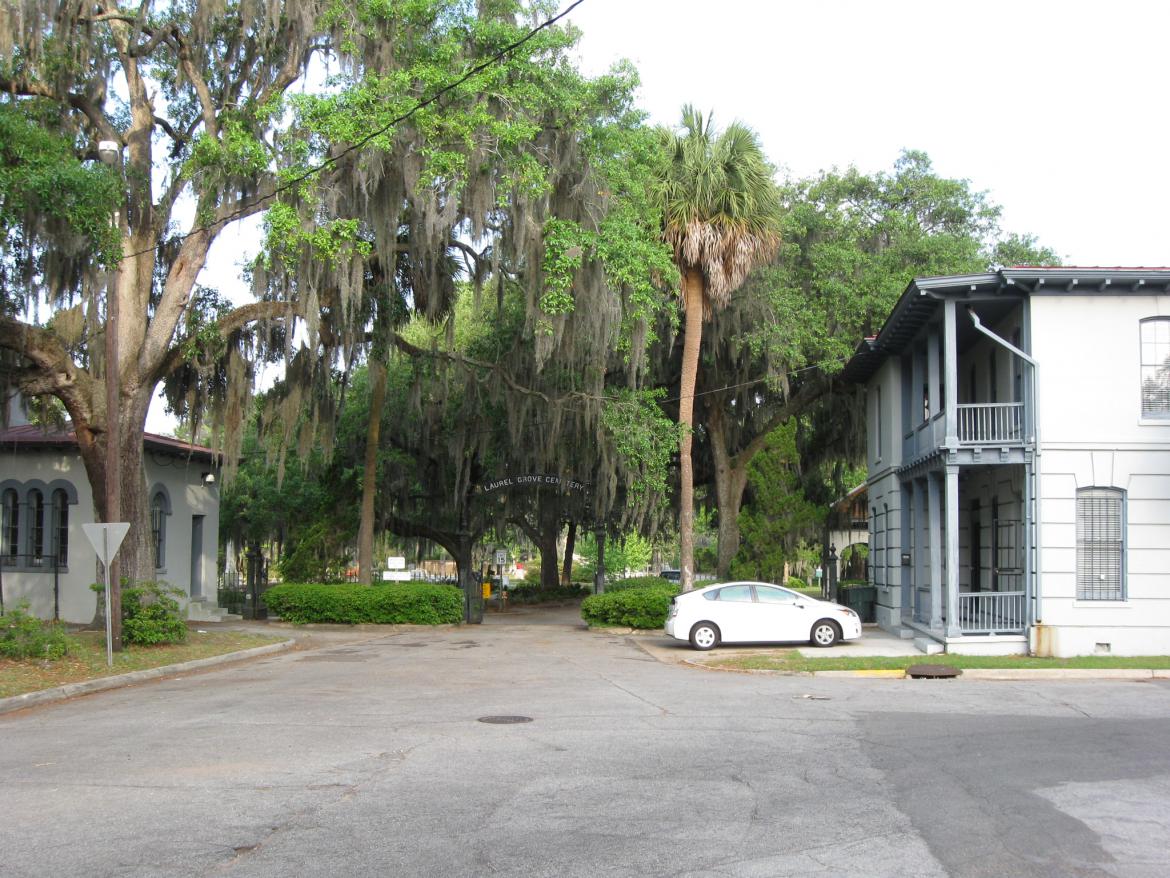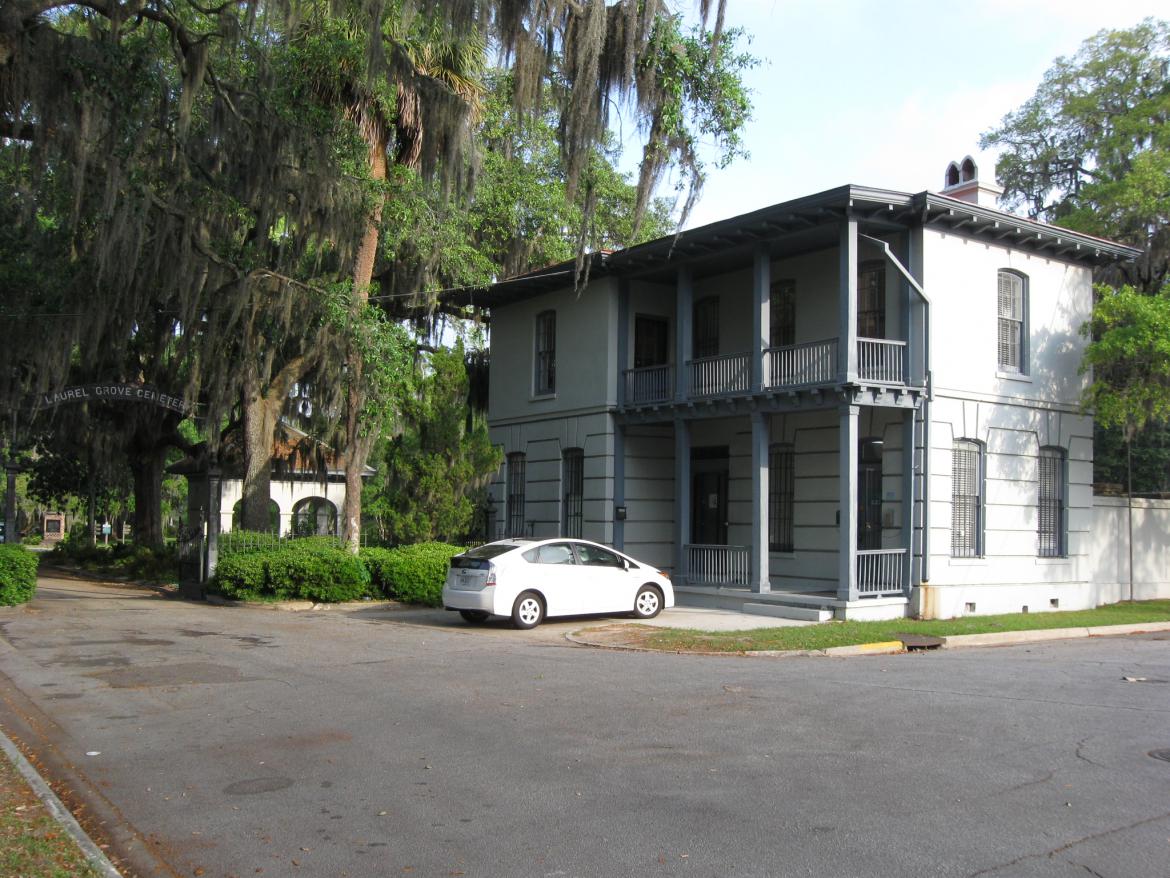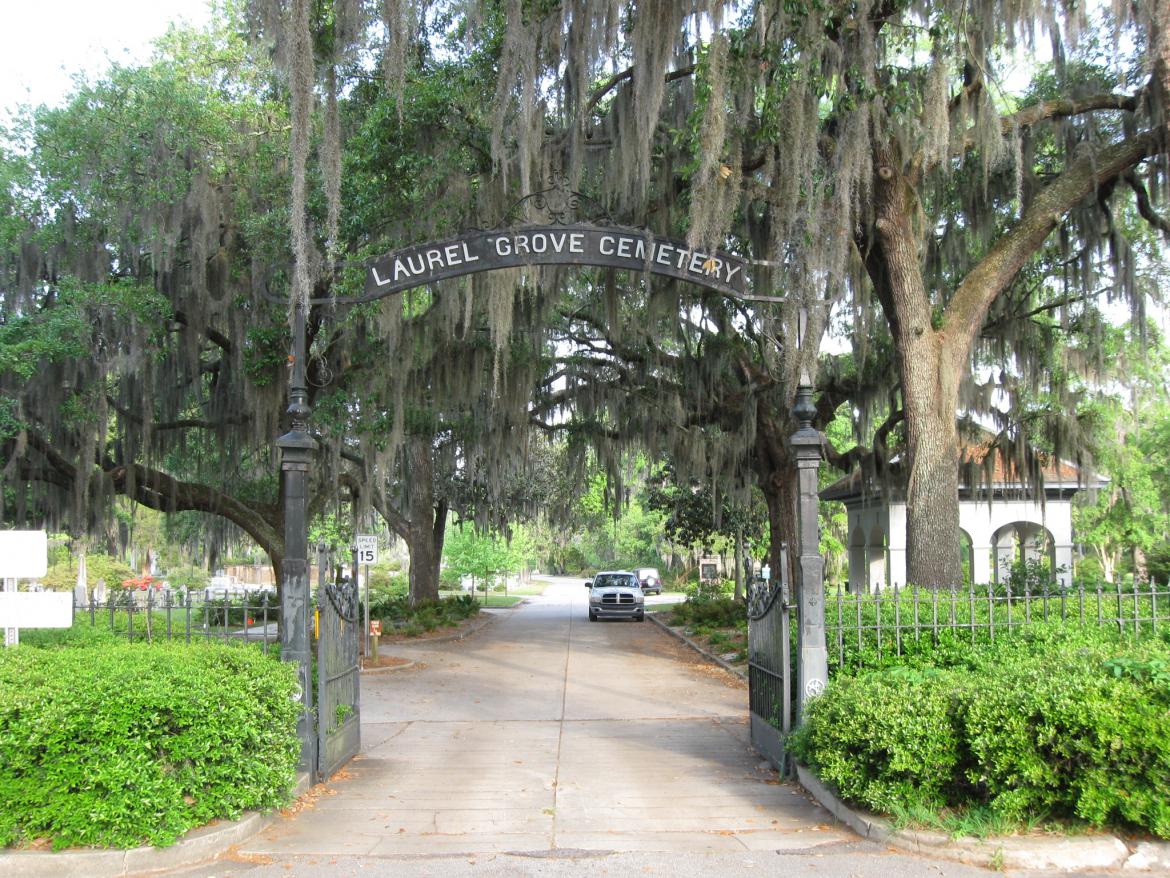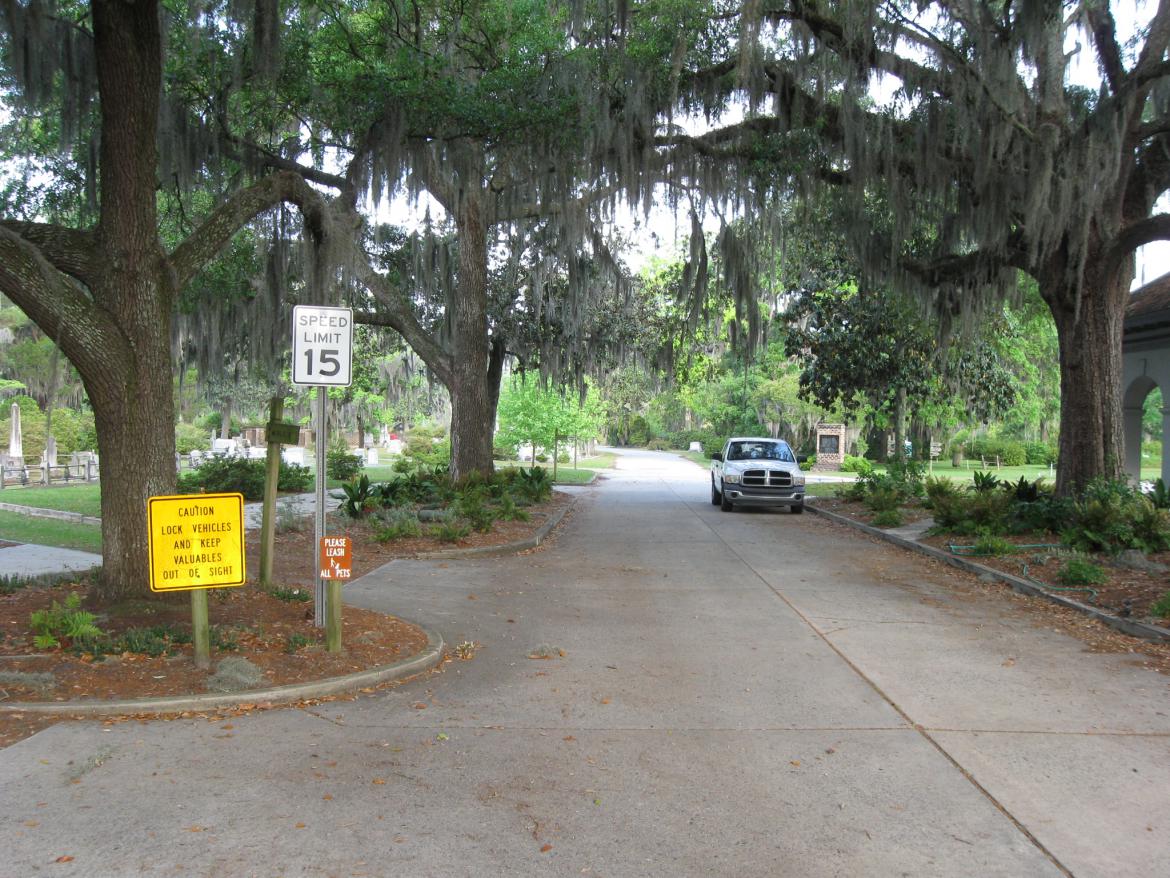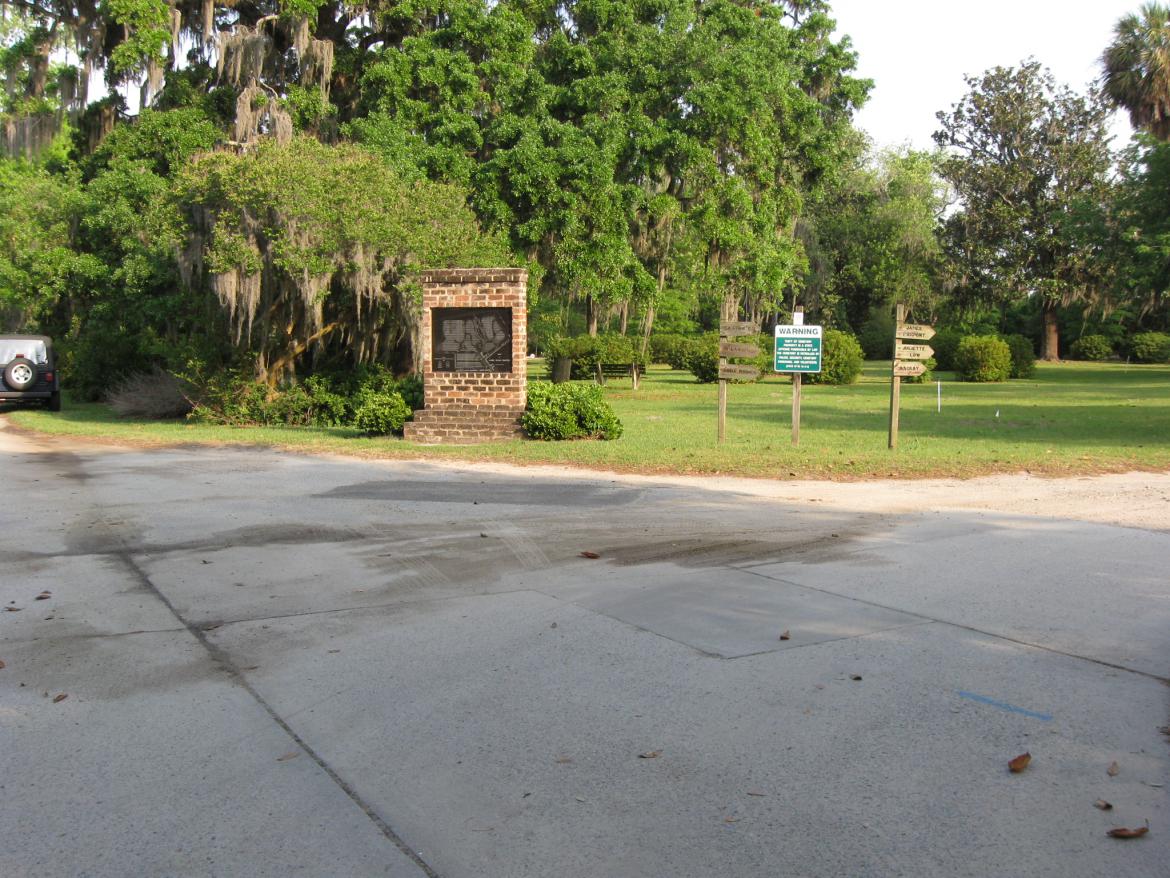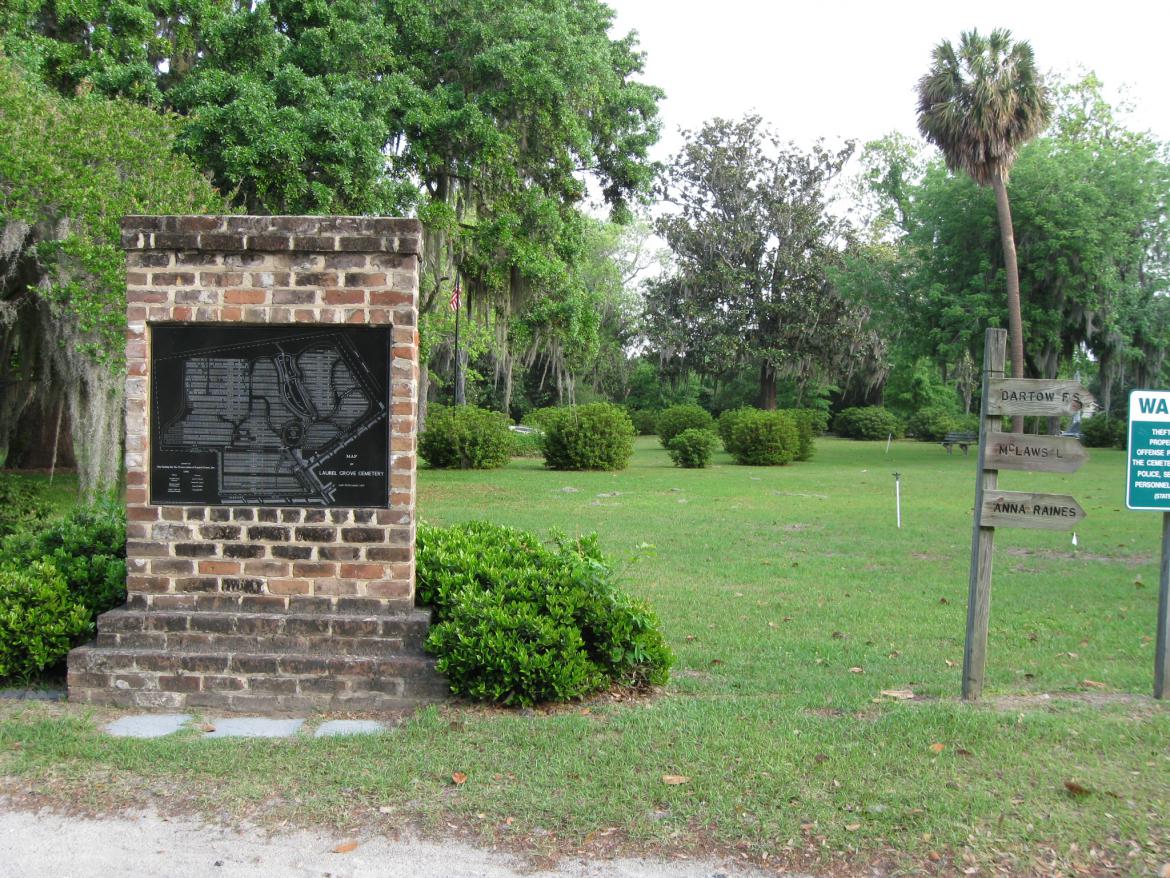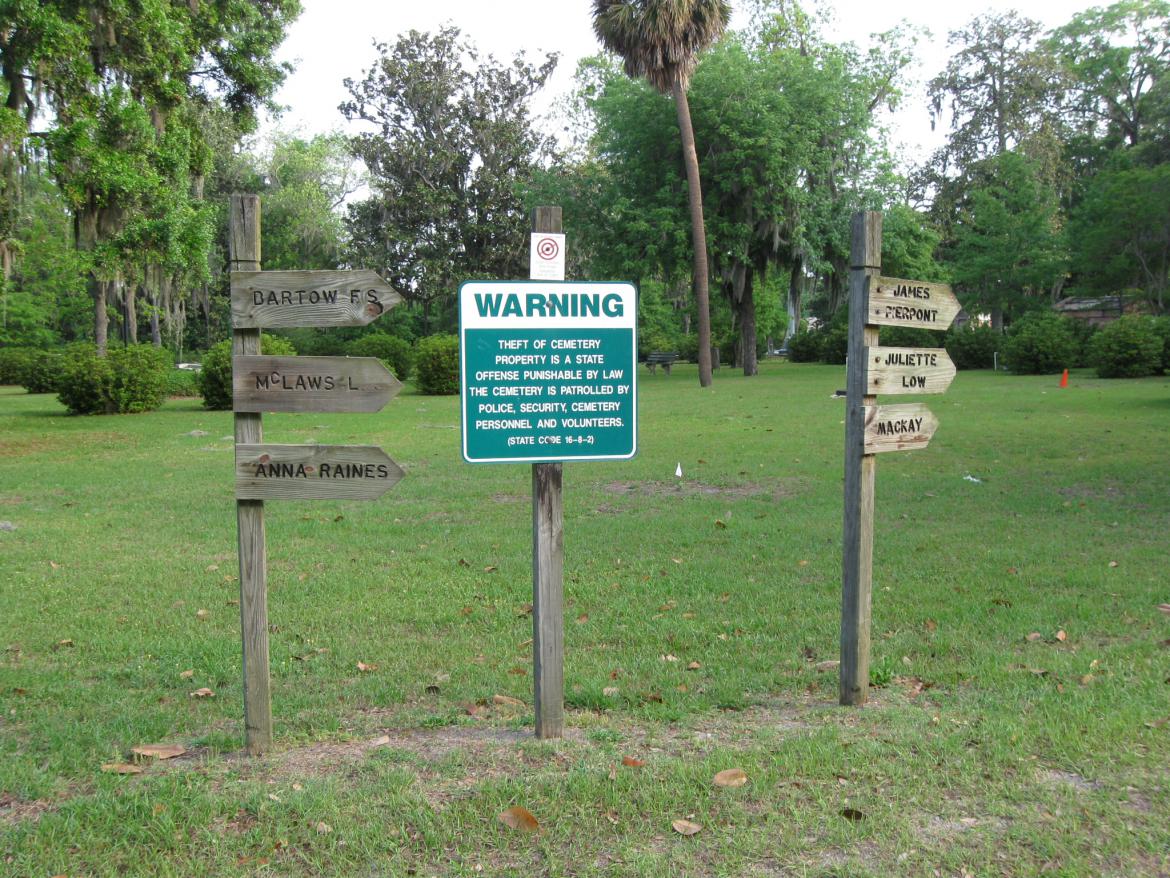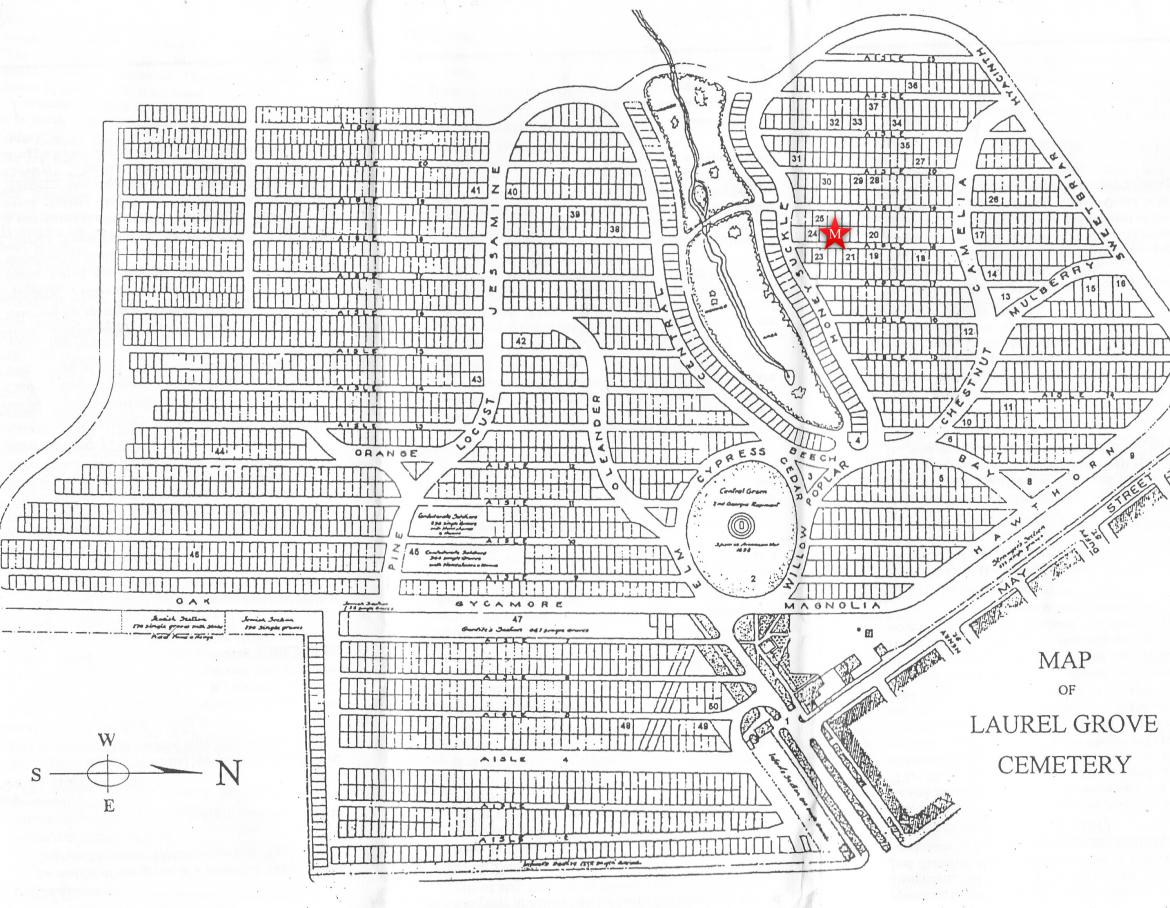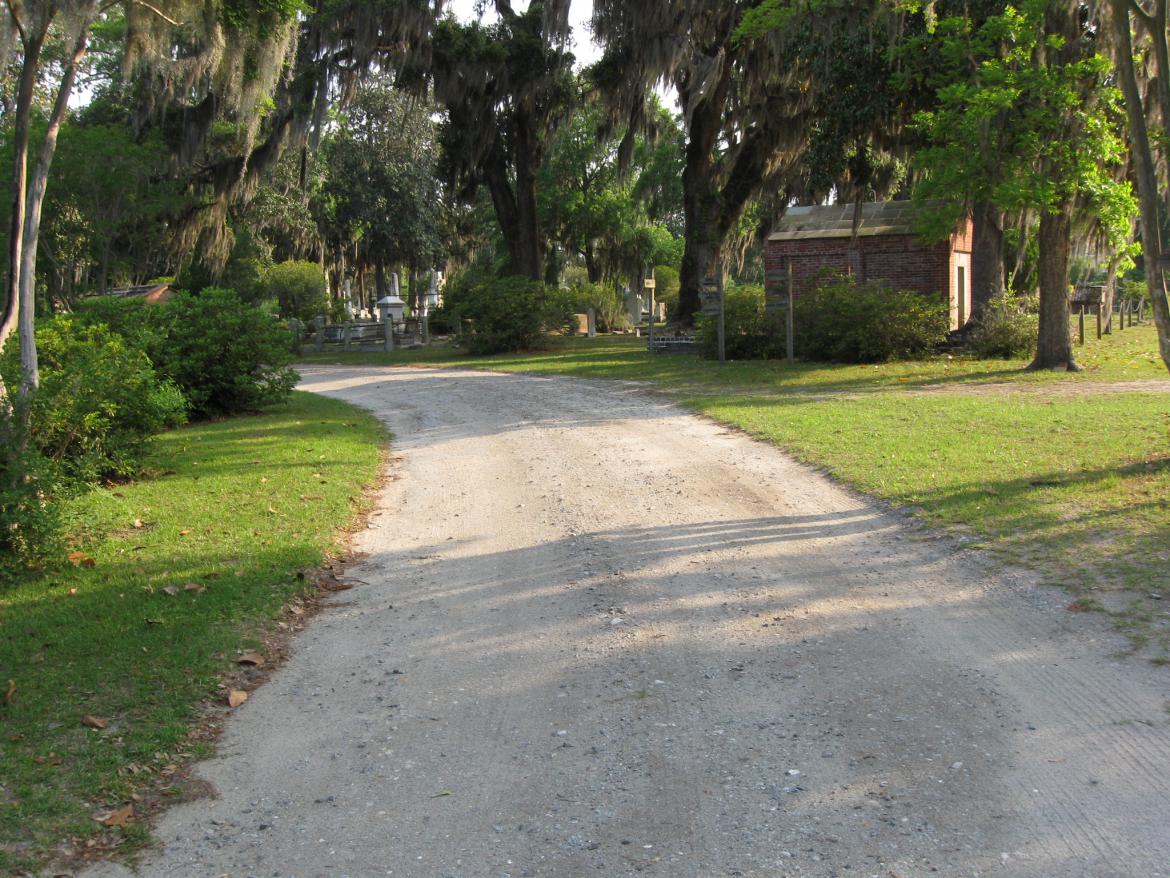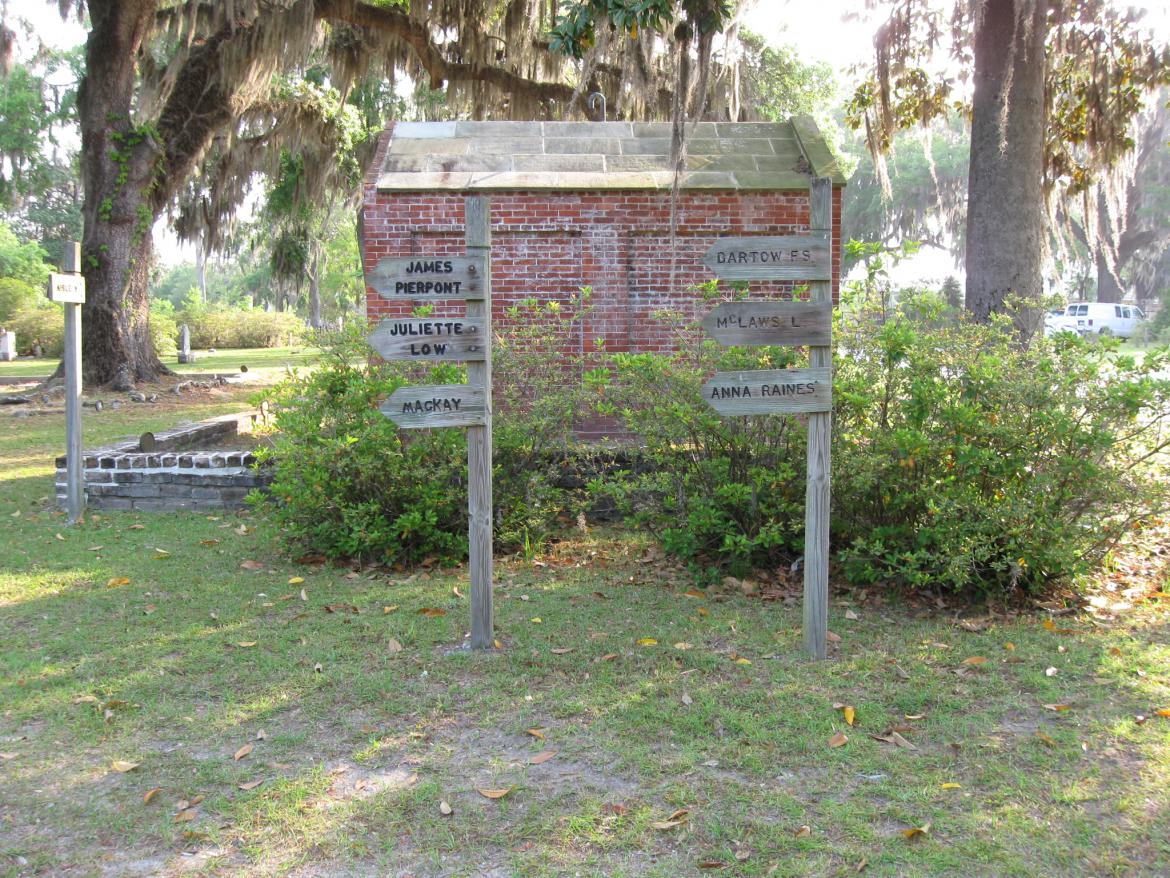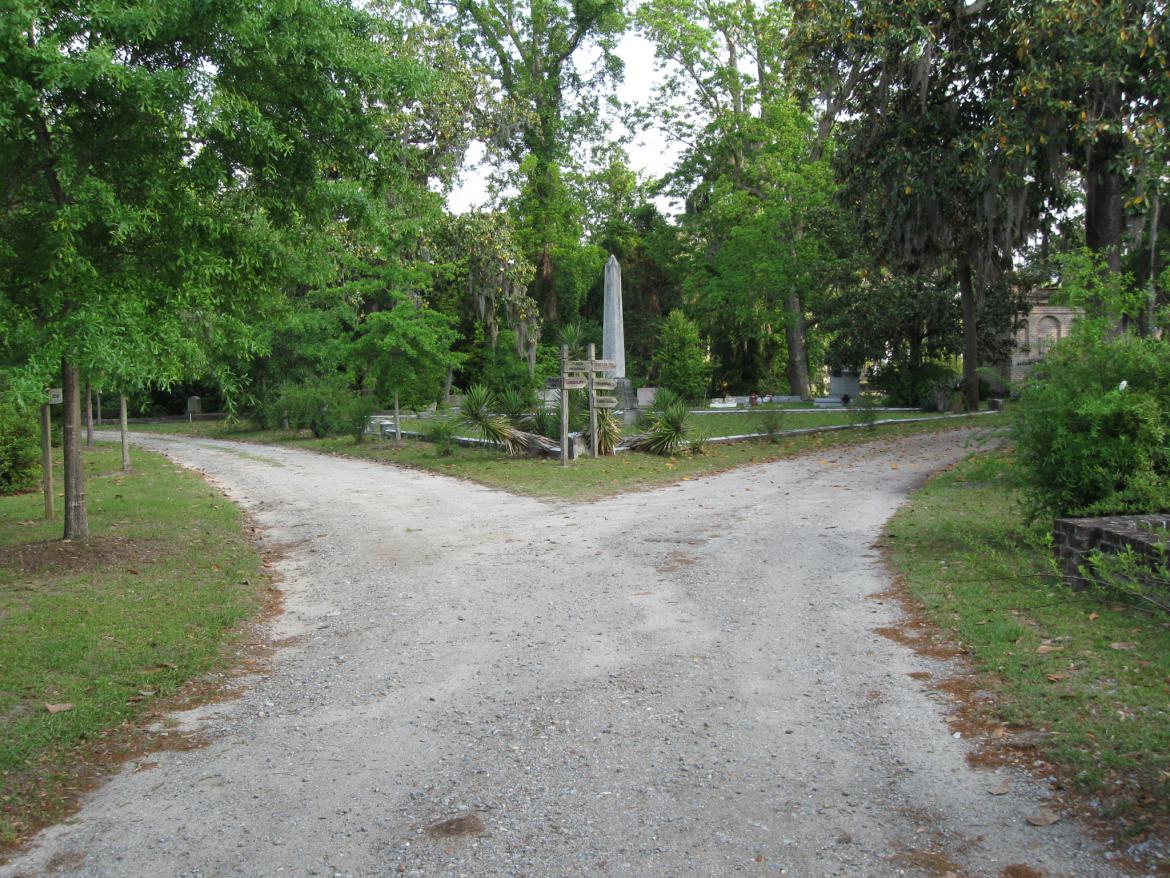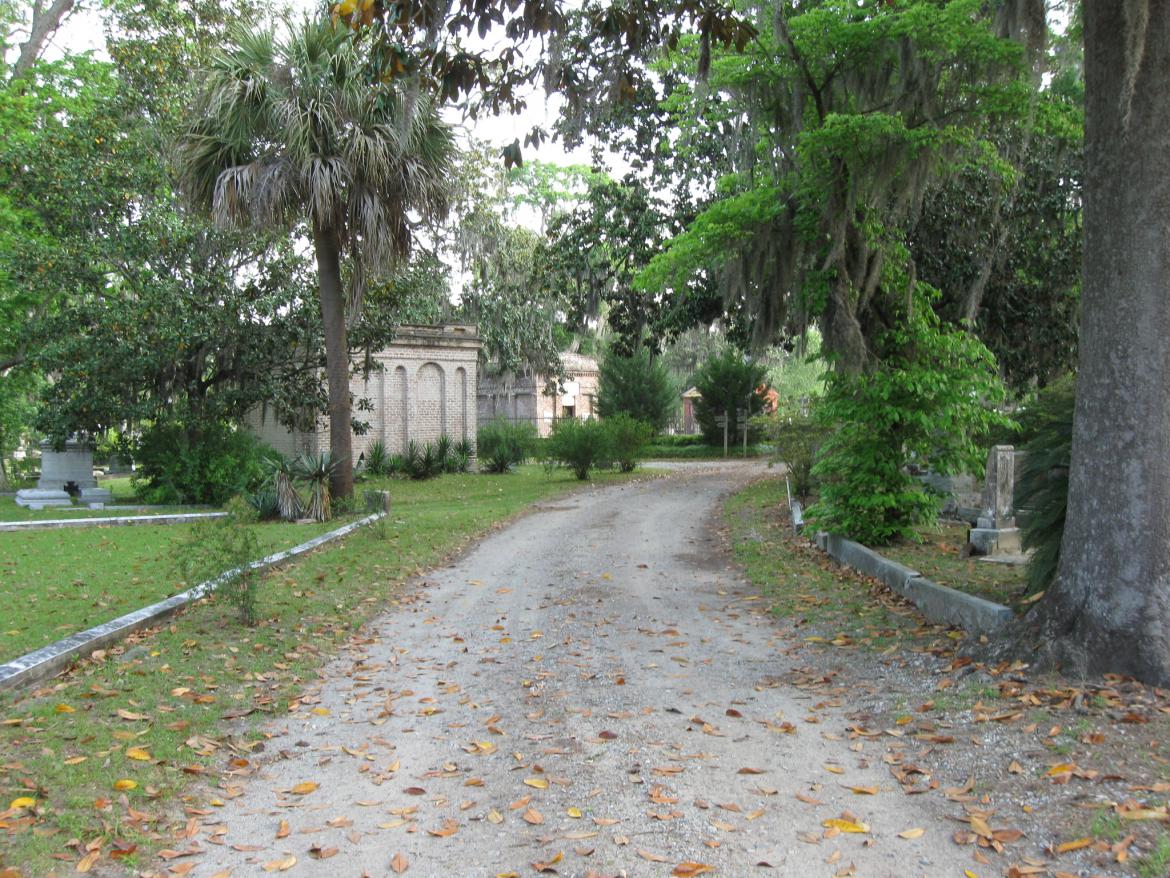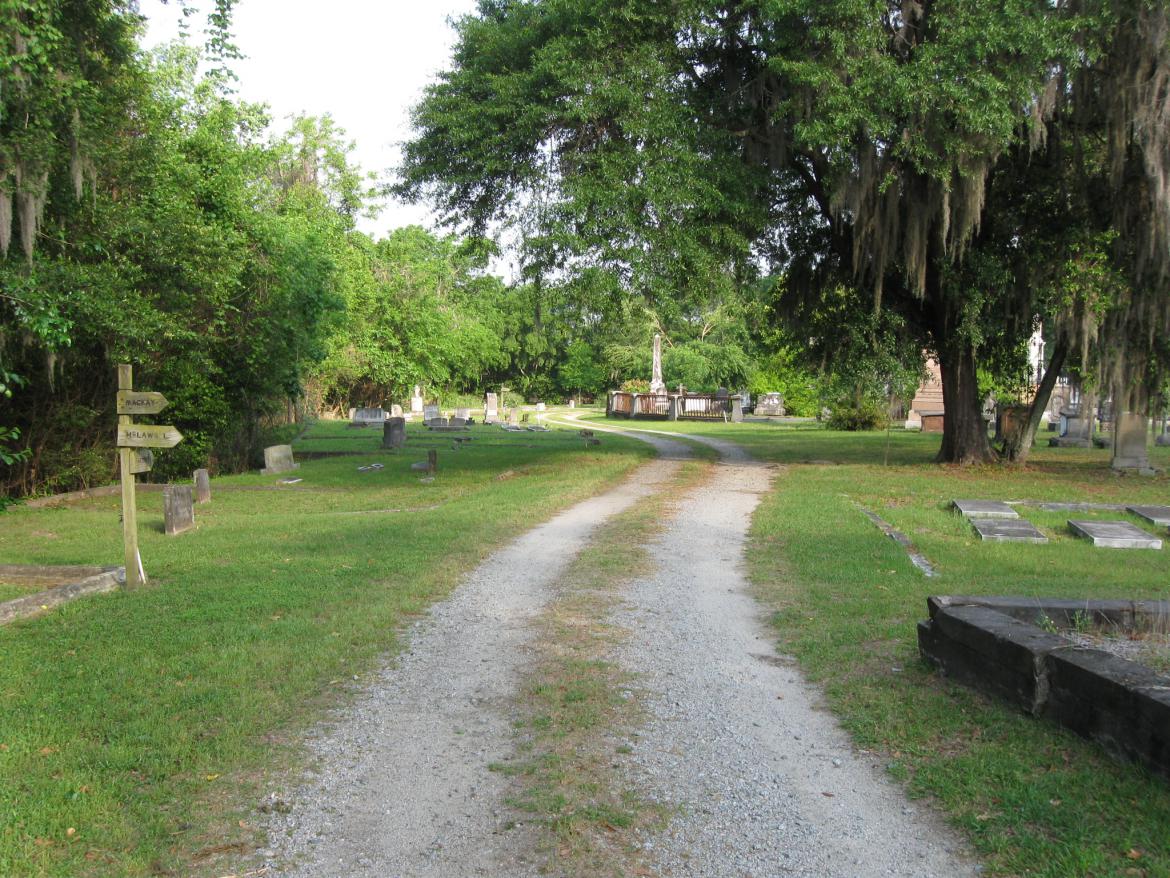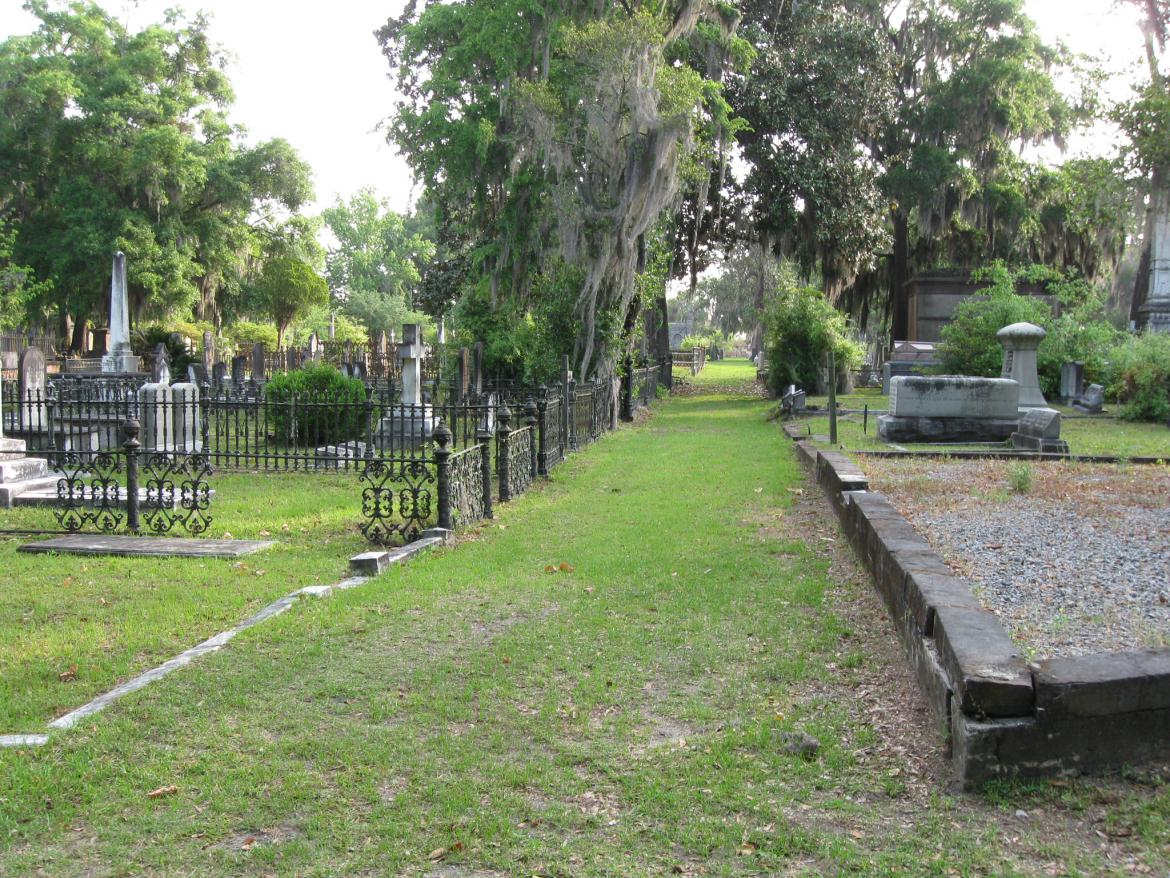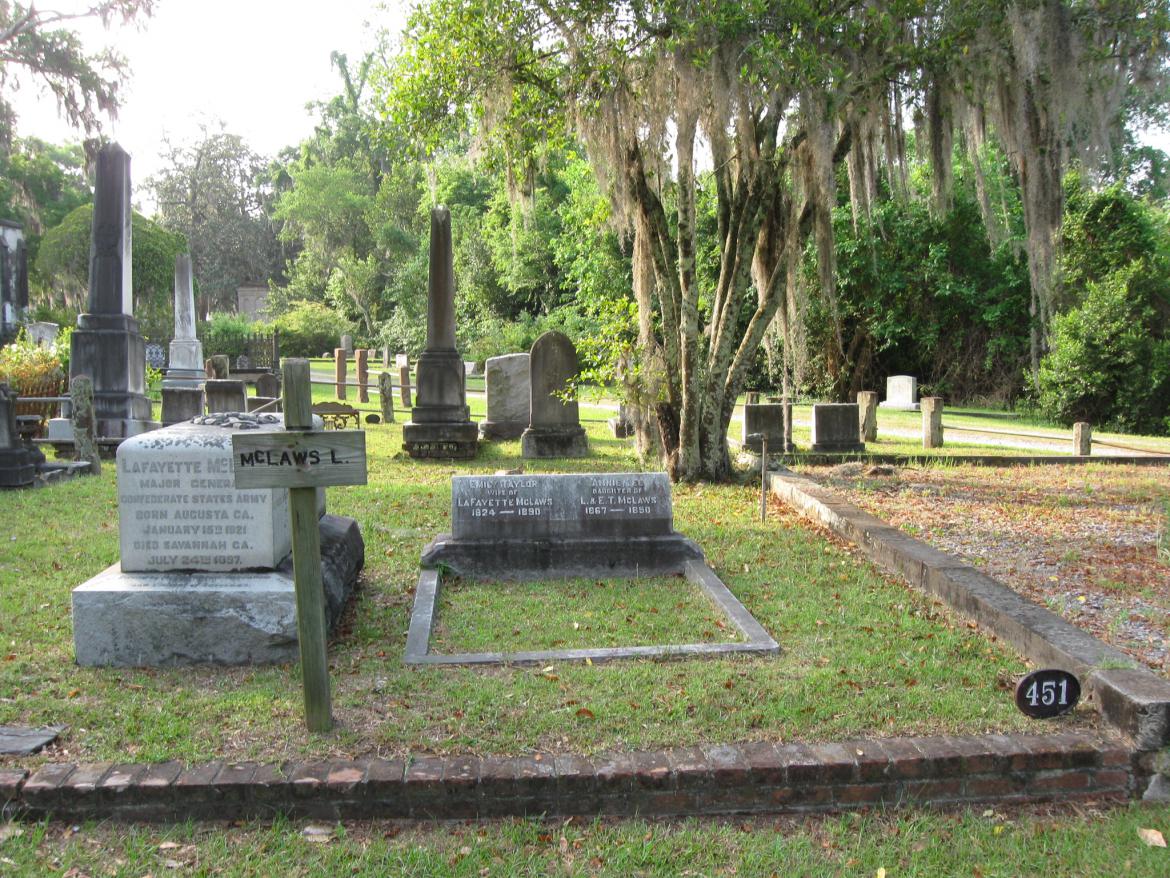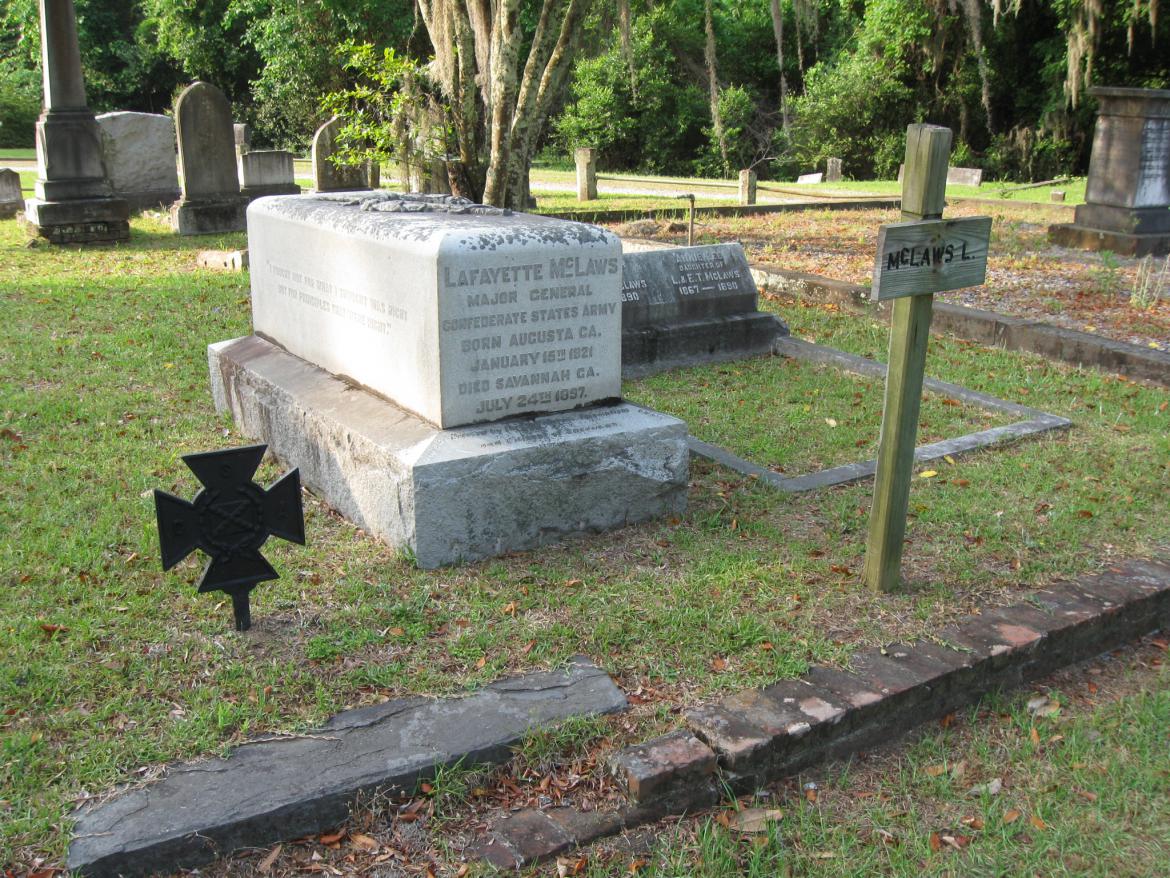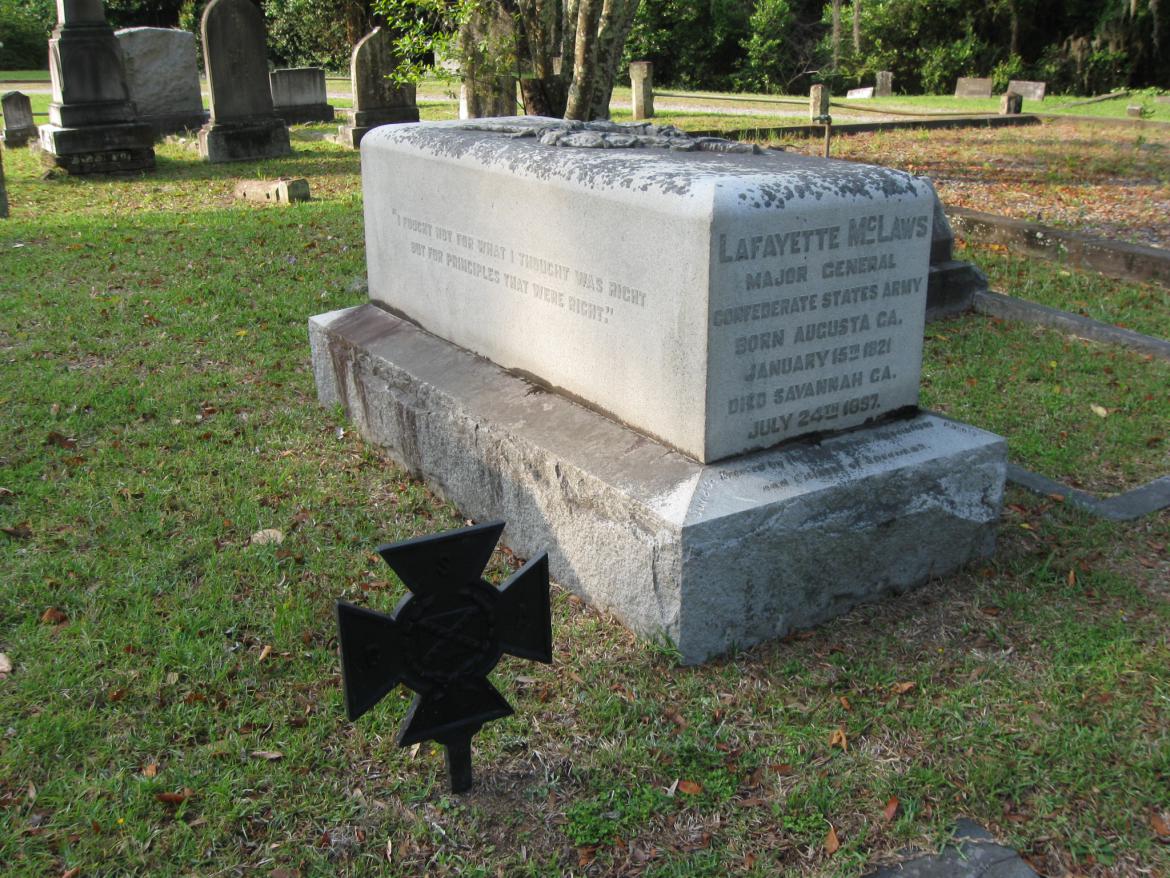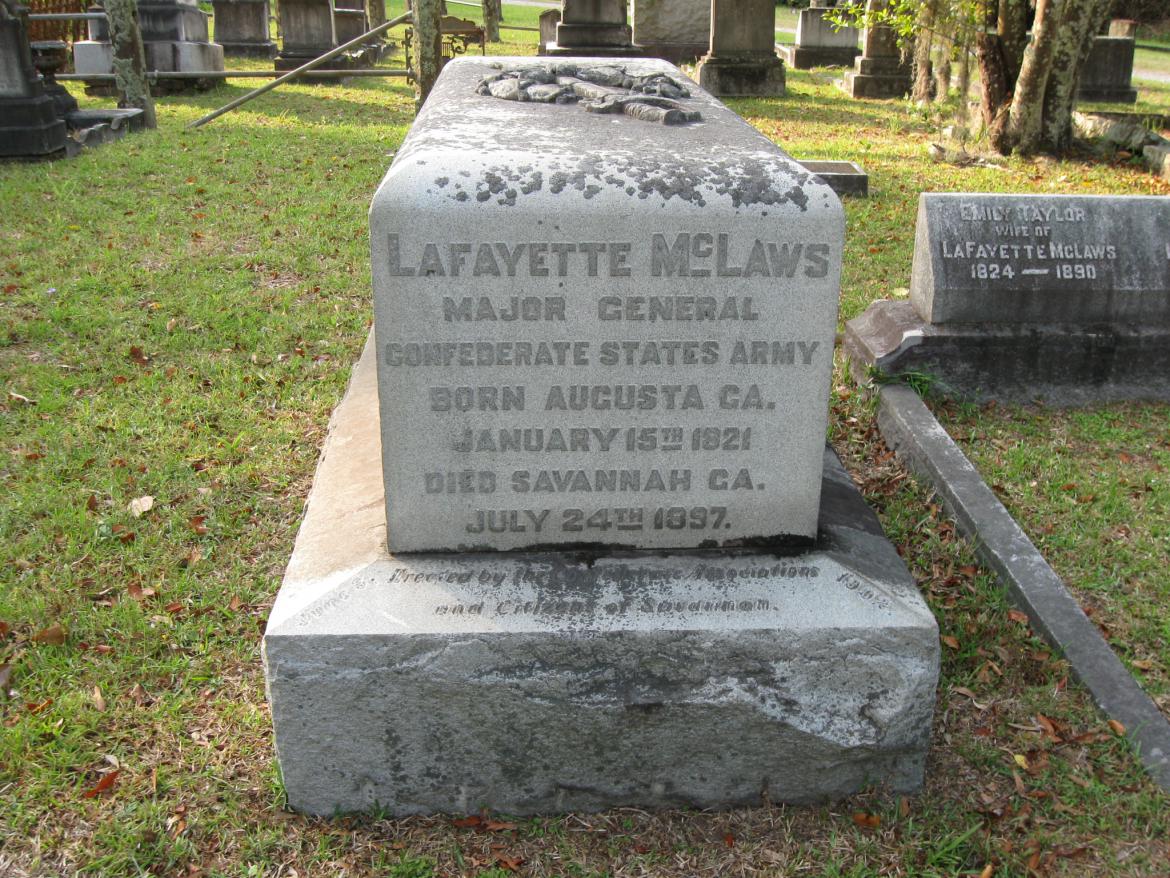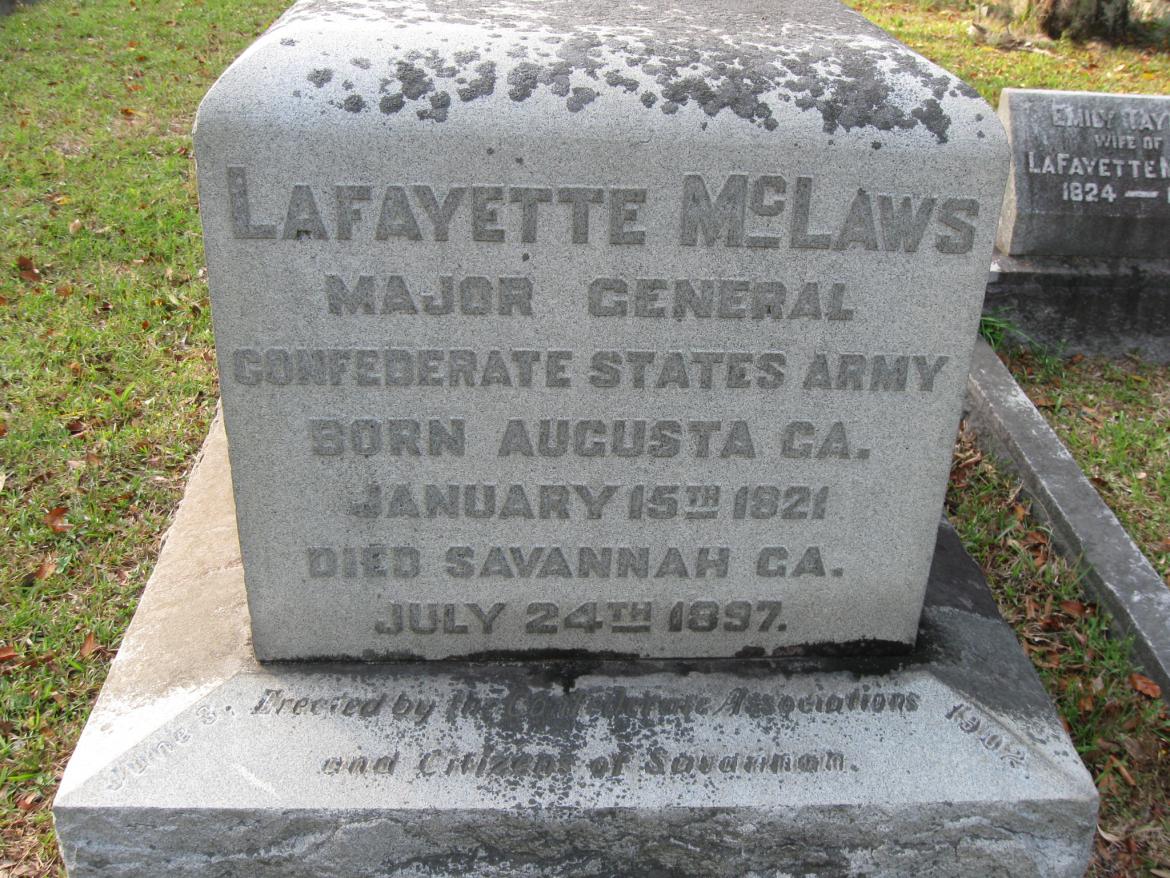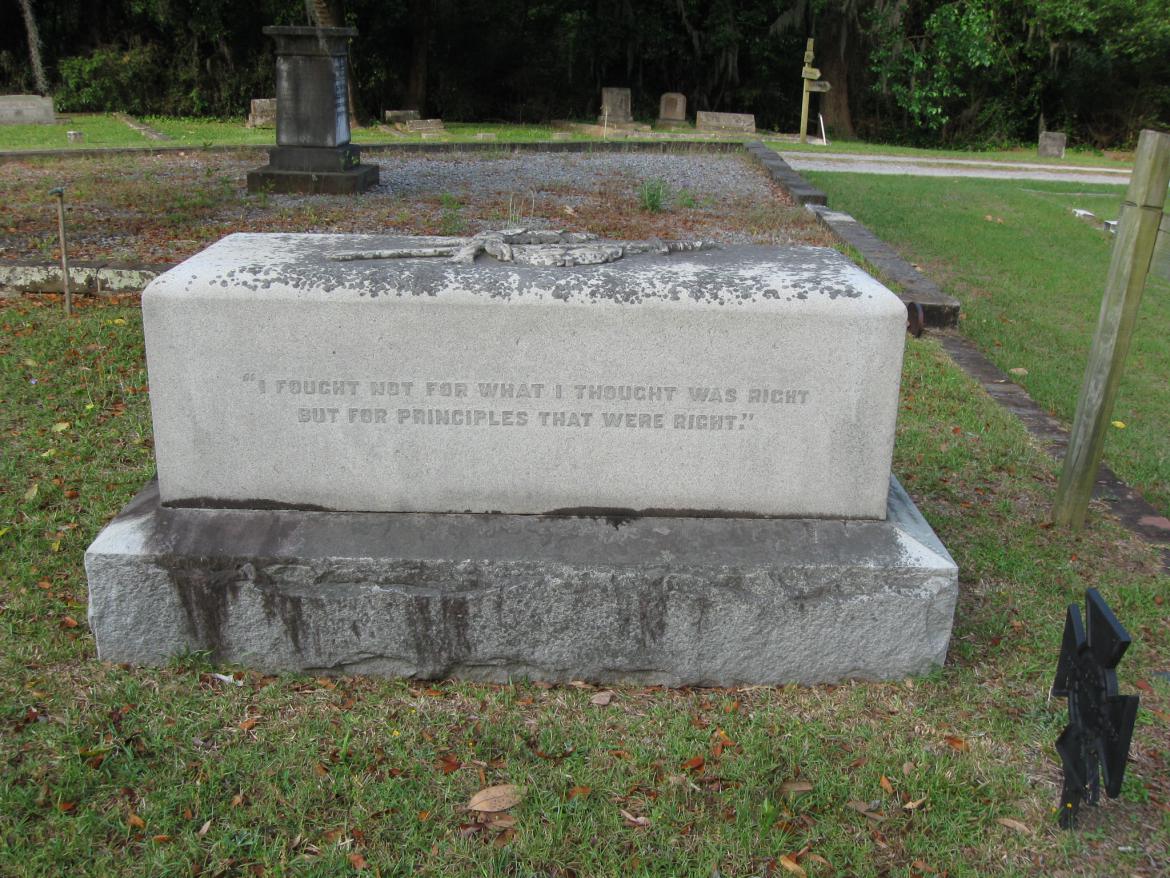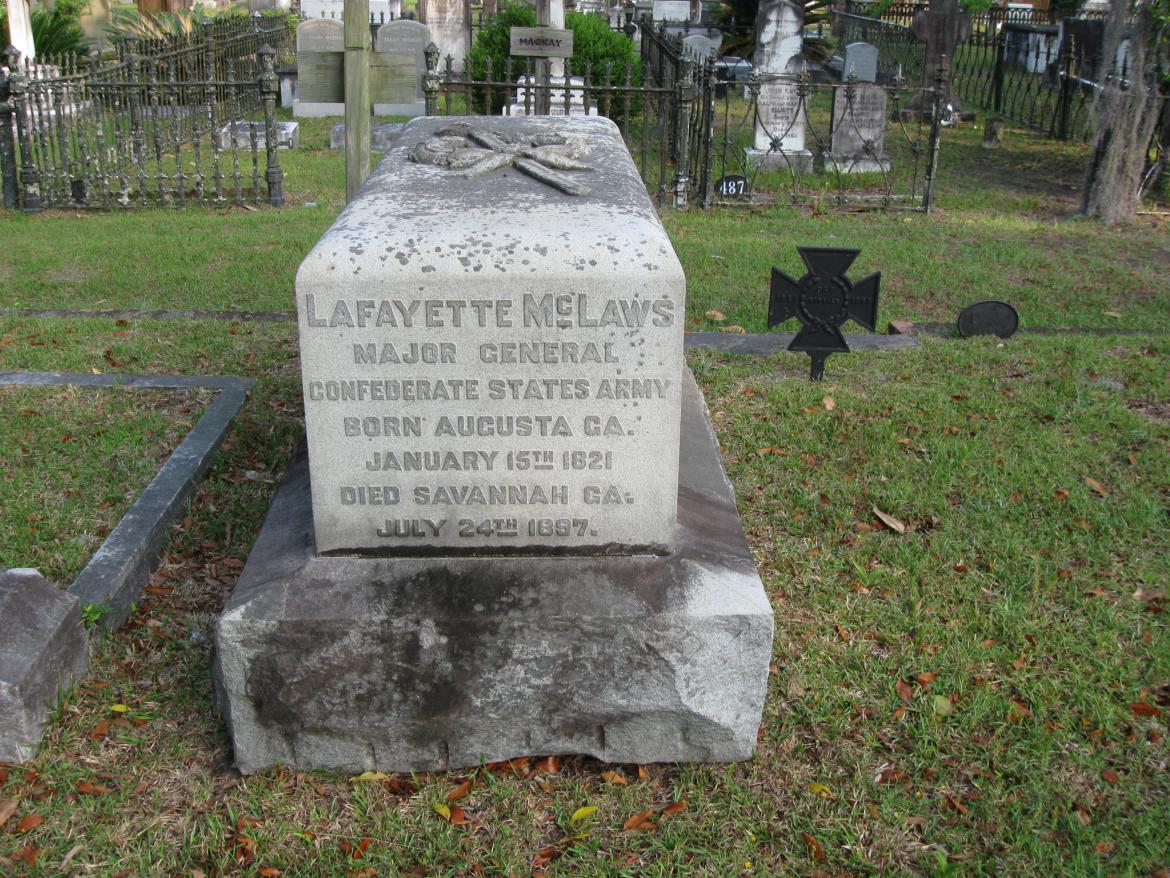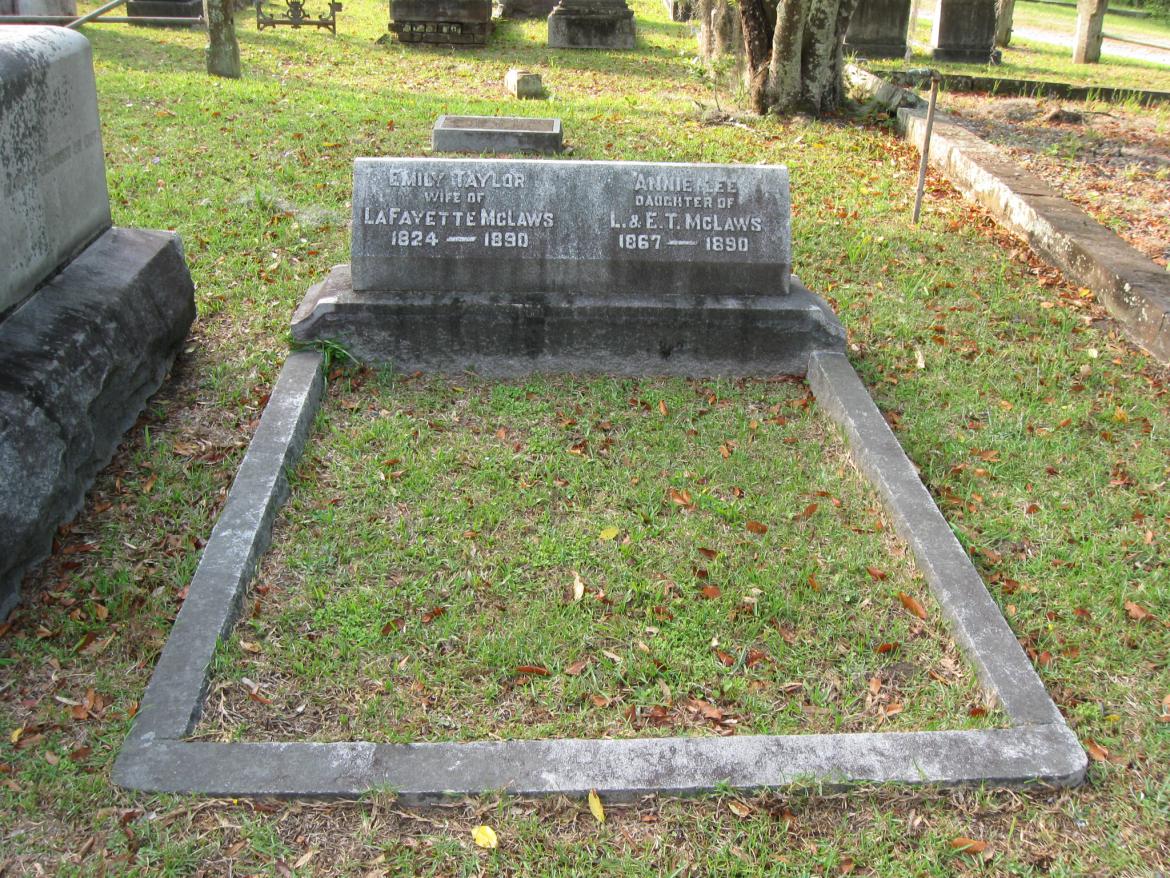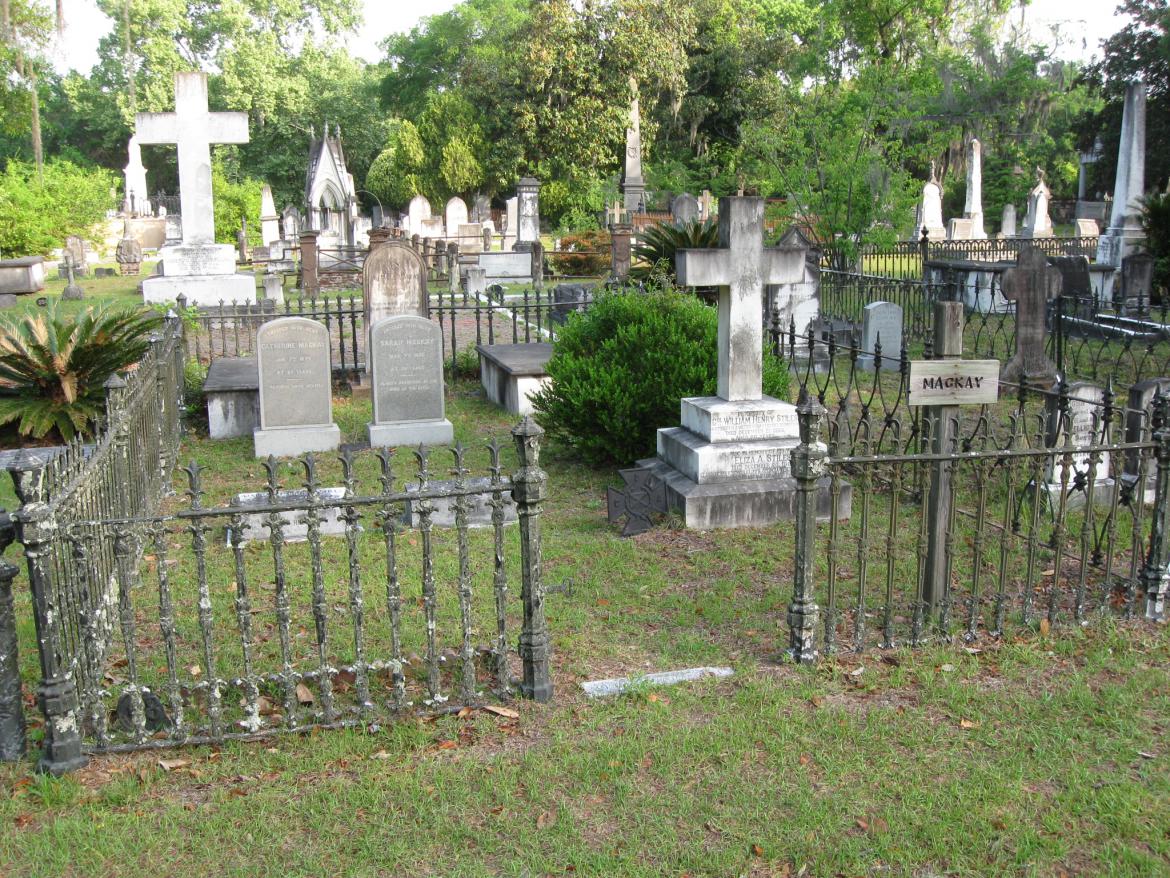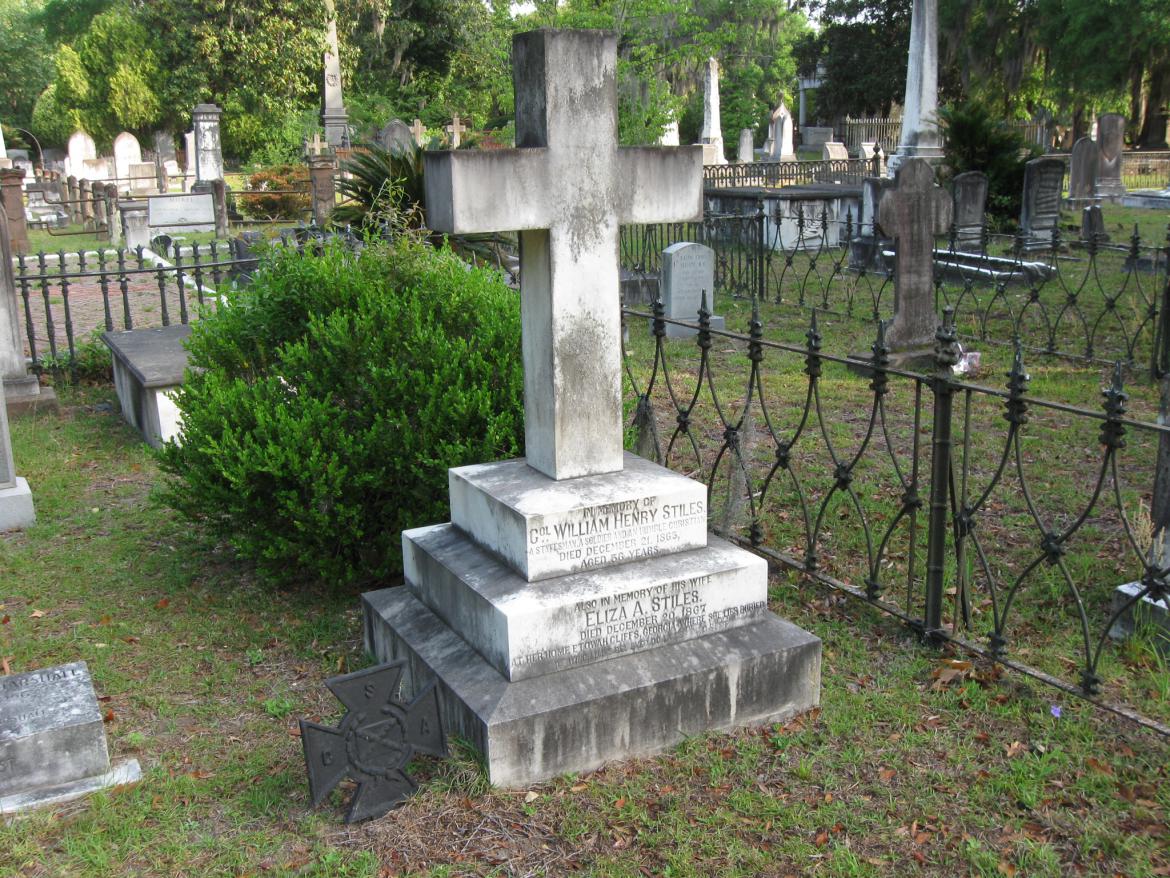In Savannah, Georgia’s Forsyth Park is a monument to Confederate Major General Lafayette McLaws (on the left) and to all Confederate soldiers from Georgia in the background. This view was taken facing south at approximately 11:30 AM on Thursday, April 21, 2011.
The Gettysburg Daily took a journey to the Savannah, Georgia area this month. One of our purposes for the visit was to find Civil War events/personalities associated with Gettysburg.
This map shows the two areas in Savannah featured in this post. #1 is the area of the Confederate Monument in Forsyth Park. #2 is Laurel Grove Cemetery. This view was taken facing north at approximately 8:30 PM on Friday, April 29, 2011.
The Confederate Monument was constructed from approximately $10,000 raised by the Savannah Ladies Memorial Association from 1868-1874. The soldier on the top of the monument was not one of the original figures. He was added in 1879. In one of our future posts we will show you one of the figures originally on top of the monument. This view was taken facing southwest at approximately 11:30 AM on Thursday, April 21, 2011.
Lafayette McLaws helped to create the Confederate Veterans Association of Savannah, and served as that organization’s first president. This view was taken facing southwest at approximately 11:30 AM on Thursday, April 21, 2011.
After McLaws died in Savannah in 1897, a movement was started to erect monuments under the direction of the Confederate Veterans Assocation to Lafayette McLaws and Francis Bartow, who had been killed at the First Battle of Manassas on July 21, 1861. This view was taken facing southwest at approximately 11:30 AM on Thursday, April 21, 2011.
The monuments/busts were created by the Hungarian or Romanian born George Julian Zolnay (1863-1949), known as “the Sculptor of the Confederacy.” Zolnay also produced monuments/busts for Confederate spy Sam Davis (Nashville, Tennessee), Soldiers’ Monument (Nashville, Tennessee), Confederate President Jefferson Davis (Davis’ grave in Richmond Virginia’s Hollywood Cemetery), and another Soldiers’ Monument (Owensboro, Kentucky). This view was taken facing southwest at approximately 11:30 AM on Thursday, April 21, 2011.
The McLaws and Bartow busts were dedicated on June 3, 1902, the anniversary of the birth of Confederate General Jefferson Davis (which was a legal holiday in Georgia). There was an elaborate parade in which various Confederate Veterans organizations, the Sons of Confederate Veterans, civic groups, and Savannah’s military groups participated. The monument/bust was unveiled by Gertrude McLaws, a granddaughter of Lafayette McLaws. This view was taken facing southwest at approximately 11:30 AM on Thursday, April 21, 2011.
However, the dedication ceremonies took place, here, in Chippewa Square, one of the many public parks in Savannah. The Bartow bust was located on the other side of the fountain. The McLaws and Bartow monuments were moved to Forsyth Park in 1910 because a large monument to Georgia founder James Oglethorpe was erected in Chippewa Square, where the fountain was located. This view was taken facing south circa the early 1900s.
The next day we visited Laurel Grove Cemetery to look for individuals associated with Gettysburg. This view was taken facing southwest at approximately 8:30 AM on Friday, April 22, 2011.
In this building, the far right door on the bottom floor, is an office where cemetery personnel can look up individuals. The computer system isn’t perfect, but overall very helpful. This view was taken facing west at approximately 8:30 AM on Friday, April 22, 2011.
The land which is now occupied by Laurel Grove had been established as the Springfield Plantation in the mid 1750s. This view was taken facing southwest at approximately 8:30 AM on Friday, April 22, 2011.
In 1850 the City of Savannah purchased 960 acres from the Trustees of Joseph Stiles, who owned Springfield Plantation. This view was taken facing southwest at approximately 8:30 AM on Friday, April 22, 2011.
100 of the 960 acres was set aside for a municipal cemetery. We were told we could park wherever we wanted, but that we might want to park closer to the entrance. This view was taken facing northwest at approximately 8:30 AM on Friday, April 22, 2011.
We parked to the left of the display with the map. The cemetery was designed in 1851 and the first burial and dedication ceremonies took place in 1852. This view was taken facing northwest at approximately 8:30 AM on Friday, April 22, 2011.
There are two Laurel Grove Cemeteries. Laurel Grove North is where most of the “white” people of Savannah were buried. Laurel Grove South contains many graves of slaves and others of African descent. We are in Laurel Grove North. This view was taken facing northwest at approximately 8:30 AM on Friday, April 22, 2011.
The map here is helpful in regard to street names in the cemetery, but it doesn’t list each individual plot number. This view was taken facing north at approximately 8:30 AM on Friday, April 22, 2011.
The directional signs listing some of the “notables” buried in Laurel Grove are very helpful. This view was taken facing northwest at approximately 8:30 AM on Friday, April 22, 2011.
This is the brochure given out to those who visit Laurel Grove. It is a handy size and points out some of the important people buried in the cemetery. There is another map which we were given that lists each burial plot, but that was too big for our scanner. We are standing south of the Circle surrounded by Cypress, Cedar, Willow and Elm Streets in the southeast quadrant of Laurel Grove. Our goal is to make it to the McLaws grave in the northeast quadrant, with the red star and the “M.” This view was taken facing west at approximately 11:30 PM on Friday, April 29, 2011.
Laurel Grove is noted for its “wide, curved streets.” They’re not that wide, but two vehicles can squeeze by each other in most cases. We are on Willow Street. This view was taken facing northeast at approximately 8:30 AM on Friday, April 22, 2011.
Again, the signs are helpful. Juliette Gordon Low founded the Girls Scouts of America. James Lord Pierpont (1822-1893) wrote the song “Jingle Bells.” It was written in 1850 in Massachusetts and copyrighted in 1857 in Georgia. Pierpont later served in the 5th Georgia Cavalry, a western theater regiment. This view was taken facing northeast at approximately 8:30 AM on Friday, April 22, 2011.
Cedar Road goes to the left. We’ll stay to the right on Poplar. One of the reasons that Laurel Grove opened in 1852 was because the primary municipal cemetery in Savannah, Colonial Cemetery, was running out of room. This view was taken facing west at approximately 8:30 AM on Friday, April 22, 2011.
Laurel Grove is also known for its elaborate vaults and mausoleums. This view was taken facing northwest at approximately 8:30 AM on Friday, April 22, 2011.
We have now taken a left on Honeysuckle. United States soldiers occupied Savannah for a couple of months after it surrendered to Major General William Tecumseh Sherman in December, 1864. They cut down trees for firewood, and supposedly that is why there is not a canopy of oak trees such as seen in other parts of Savannah. However, there are still a lot of trees here. This view was taken facing southwest at approximately 8:30 AM on Friday, April 22, 2011.
We are now in the area of Aisle 18 which is to our right. This view was taken facing southwest at approximately 8:30 AM on Friday, April 22, 2011.
The sign tells us that Lafayette McLaws is to our right. This view was taken facing northwest at approximately 8:30 AM on Friday, April 22, 2011.
We’ll start walking down Aisle 18, and the McLaws burial plot is coming up on our right. This view was taken facing north at approximately 8:30 AM on Friday, April 22, 2011.
The McLaws plot is #451. This view was taken facing northeast at approximately 8:30 AM on Friday, April 22, 2011.
McLaws was born in Augusta, Georgia, and did not settle in Savannah until after the Civil War. This view was taken facing east at approximately 11:30 AM on Thursday, April 21, 2011.
After the war, McLaws held various jobs, including an insurance agent in Augusta, and a collector for the Internal Revenue Service, and Postmaster for Savannah. This view was taken facing southeast at approximately 8:30 AM on Friday, April 22, 2011.
To the left of McLaws’ grave is a “Southern Cross of Honor.” The Confederate flag surrounded by the laurel wreath is actually the back of the iron cross. The front has the words “Deo Vindice (God our Vindicator) 1861-1865.” This view was taken facing southeast at approximately 8:30 AM on Friday, April 22, 2011.
The monument at his grave was “Erected by the Confederate Associations and Citizens of Savannah,” the same groups responsible for his monument in Forsyth Park. This view was taken facing east at approximately 8:30 AM on Friday, April 22, 2011.
McLaws died of “acute indigestion” on the morning of July 24, 1897. This view was taken facing east at approximately 8:30 AM on Friday, April 22, 2011.
McLaws commanded a division in the First Corps, Army of Northern Virginia at Gettysburg. This view was taken facing south at approximately 8:30 AM on Friday, April 22, 2011.
On July 2, 1863, his division attacked Sickles’ Third Corps in the areas of the Emmitsburg Road, Peach Orchard, Wheatfield, and Trostle Farm. This view was taken facing south at approximately 8:30 AM on Friday, April 22, 2011.
McLaws’ immediate superior at Gettysburg was James Longstreet. In a private letter to his wife written on July 7, 1863, McLaws wrote about Longstreet, “during the engagement he was very excited giving contradictory orders to everyone, and ewas exceedingly overbearing. I consider him a humbug– a man of small capacity, very ostinate, not at all chivalrous, exceedingly conceited, and totally selfish.” This view was taken facing west at approximately 8:30 AM on Friday, April 22, 2011.
On December 17, 1863 following the Battle of Fort Sanders, near Knoxville, Tennessee, McLaws was relieved of command by Longstreet. McLaws demanded a court-martial and was cleared of all charges. On May 18, 1864 he was placed in command of the defenses of Savannah. This view was taken facing north at approximately 8:30 AM on Friday, April 22, 2011.
McLaws married Emily Allison Taylor, a niece of President Zachary Taylor. After McLaws’ term of postmaster expired, the McLaws took in boarders in Savannah because at that time, there was not a pension for a Confederate officer. Their daughter, Virginia stated, “We got along the best we could, each one doing his part.” Annie Lee McLaws (1867-1890) was a Savannah school teacher who was died from the effects of typhoid fever on March 6, 1890. Her mother, Emily Allison Taylor McLaws (1824-1890) was exposed to typhoid fever, and died on May 22, 1890. So Lafayette McLaws lost a daughter and his wife within two months of each other. This view was taken facing east at approximately 8:30 AM on Friday, April 22, 2011.
Opposite the McLaws plot, on the west side of aisle 18 is the Mackay plot. This view was taken facing west at approximately 8:30 AM on Friday, April 22, 2011.
We were interested in Colonel William Henry Stiles, buried in the Mackay plot. He was a United States Congressman, and his family had owned the Springfield Plantation, part of which became Laurel Grove Cemetery. During the Chancellorsville Campaign he commanded the 60th Georgia Infantry Regiment, but he was not present at Gettysburg. The 60th Georgia was part of John Brown Gordon’s Brigade which successfully attack the area of Barlow’s Knoll on July 1, 1863. It appears that Stiles had become ill following the Chancellorsville Campaign and returned to Savannah, where he died on December 21, 1865. This view was taken facing northwest at approximately 8:30 AM on Friday, April 22, 2011.

